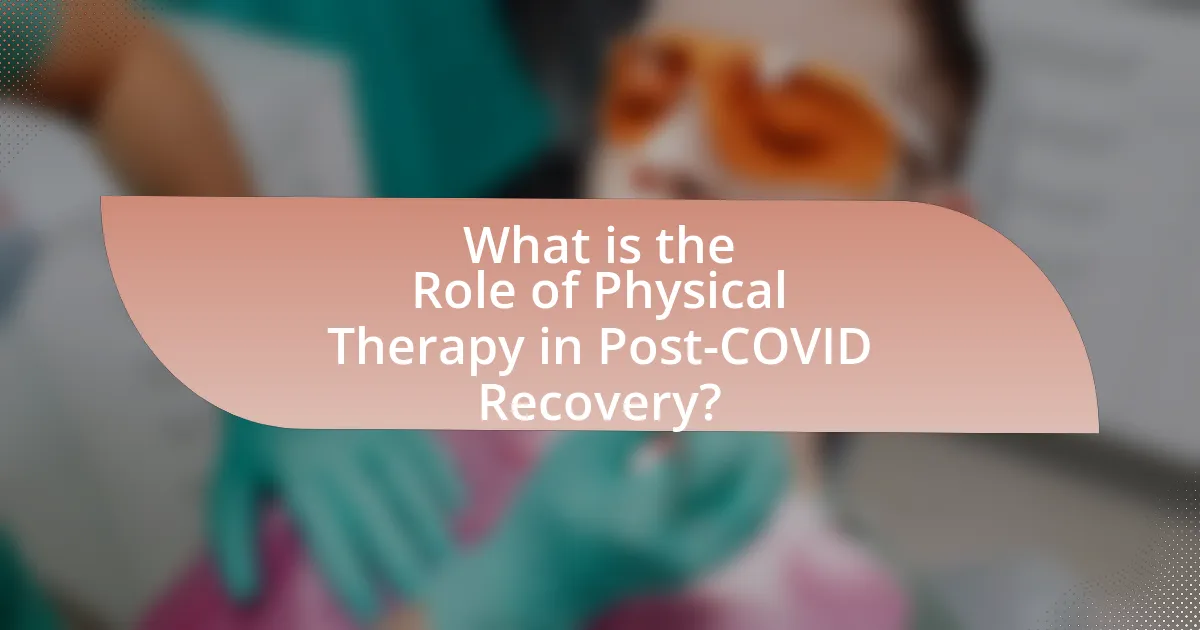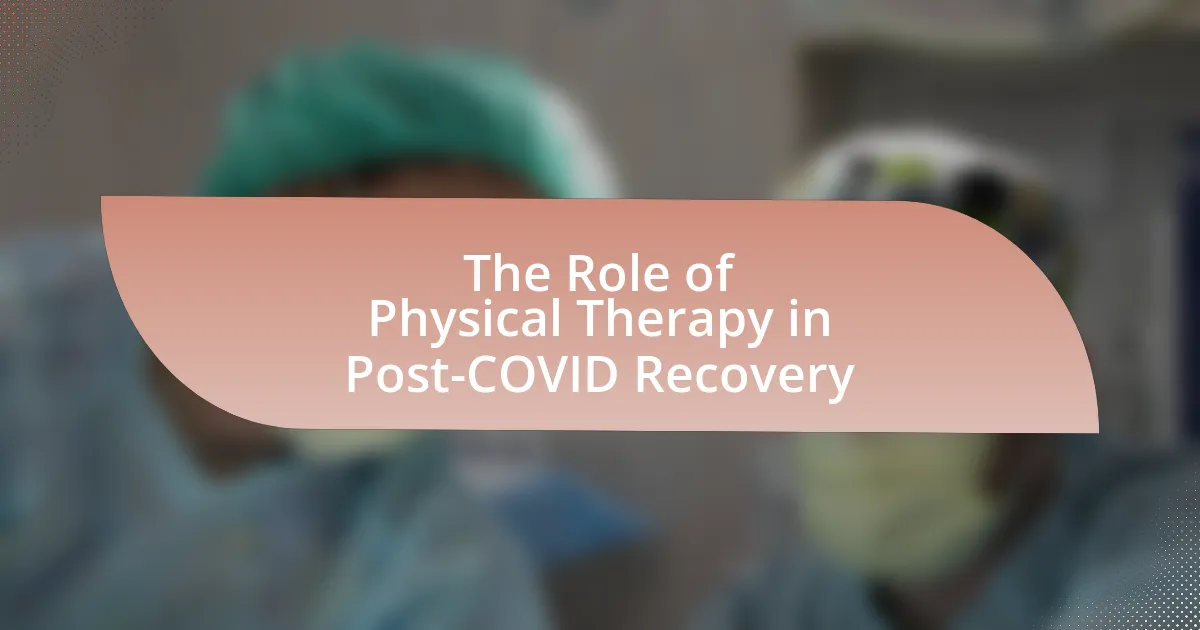Physical therapy is essential for individuals recovering from COVID-19, addressing physical impairments such as muscle weakness, fatigue, and respiratory issues. Tailored rehabilitation programs significantly improve strength, mobility, and overall quality of life for post-COVID patients. Key components of physical therapy include respiratory rehabilitation, strength training, and functional mobility training, utilizing exercises like aerobic conditioning and breathing techniques to enhance recovery. Patients can access physical therapy through various settings, including outpatient clinics and telehealth services, while overcoming challenges such as emotional distress and physical limitations is crucial for successful rehabilitation.

What is the Role of Physical Therapy in Post-COVID Recovery?
Physical therapy plays a crucial role in post-COVID recovery by helping individuals regain strength, improve mobility, and manage lingering symptoms such as fatigue and respiratory issues. Research indicates that many COVID-19 survivors experience physical impairments, including muscle weakness and reduced endurance, which can be effectively addressed through tailored physical therapy programs. A study published in the journal “Physical Therapy” found that patients who engaged in structured rehabilitation reported significant improvements in functional capacity and quality of life. Thus, physical therapy is essential for facilitating recovery and enhancing overall well-being in post-COVID patients.
How does physical therapy aid in the recovery process after COVID-19?
Physical therapy aids in the recovery process after COVID-19 by improving respiratory function, enhancing physical strength, and addressing fatigue. Research indicates that many COVID-19 survivors experience lingering symptoms, including reduced lung capacity and muscle weakness. Physical therapists utilize targeted exercises to strengthen respiratory muscles and improve endurance, which is crucial for restoring overall health. A study published in the journal “Physical Therapy” found that patients who engaged in structured rehabilitation programs reported significant improvements in their physical performance and quality of life. This evidence supports the effectiveness of physical therapy in facilitating recovery from the physical impacts of COVID-19.
What specific physical challenges do COVID-19 survivors face?
COVID-19 survivors face specific physical challenges such as persistent fatigue, muscle weakness, and respiratory issues. Research indicates that approximately 30% of individuals recovering from COVID-19 experience long-term symptoms, commonly referred to as “long COVID,” which includes these physical challenges. Studies have shown that survivors may struggle with reduced exercise capacity and difficulty performing daily activities due to these lingering effects. For instance, a study published in the Journal of the American Medical Association found that 87% of patients reported at least one persistent symptom, with fatigue and muscle weakness being among the most common.
How does physical therapy address these challenges?
Physical therapy addresses challenges in post-COVID recovery by employing targeted rehabilitation techniques to improve physical function, reduce symptoms, and enhance overall quality of life. These techniques include personalized exercise programs, manual therapy, and education on breathing strategies, which collectively aim to restore strength, flexibility, and endurance. Research indicates that structured physical therapy interventions can significantly reduce fatigue and improve respiratory function in post-COVID patients, as evidenced by a study published in the Journal of Rehabilitation Medicine, which found that patients who underwent physical therapy reported a 30% improvement in functional capacity after a 12-week program.
What are the key components of physical therapy for post-COVID patients?
The key components of physical therapy for post-COVID patients include respiratory rehabilitation, strength training, functional mobility training, and education on self-management strategies. Respiratory rehabilitation focuses on improving lung function and breathing techniques, which is crucial as many post-COVID patients experience respiratory issues. Strength training helps rebuild muscle mass and endurance, addressing the physical deconditioning that can occur after prolonged illness. Functional mobility training assists patients in regaining their ability to perform daily activities, enhancing their overall quality of life. Education on self-management strategies empowers patients to take an active role in their recovery, promoting long-term health and wellness. These components are essential for addressing the multifaceted challenges faced by individuals recovering from COVID-19.
What types of exercises are commonly used in post-COVID physical therapy?
Commonly used exercises in post-COVID physical therapy include aerobic conditioning, strength training, flexibility exercises, and breathing exercises. Aerobic conditioning, such as walking or cycling, helps improve cardiovascular endurance, which is often compromised after COVID-19. Strength training focuses on rebuilding muscle strength, particularly in individuals who experienced significant fatigue or weakness. Flexibility exercises enhance range of motion and reduce stiffness, while breathing exercises, including diaphragmatic and pursed-lip breathing, are crucial for improving lung function and respiratory efficiency. These exercise types are supported by clinical guidelines and studies indicating their effectiveness in aiding recovery and improving quality of life for post-COVID patients.
How do these exercises promote recovery and rehabilitation?
Exercises promote recovery and rehabilitation by enhancing physical function, reducing symptoms, and improving overall well-being in post-COVID patients. These exercises facilitate increased blood circulation, which aids in the delivery of oxygen and nutrients to tissues, thereby accelerating healing. Additionally, they help restore muscle strength and flexibility, which are often compromised during illness. Research indicates that structured exercise programs can significantly improve respiratory function and endurance in individuals recovering from COVID-19, as evidenced by a study published in the Journal of Rehabilitation Medicine, which found that patients who engaged in physical therapy reported better outcomes in terms of mobility and quality of life.
What benefits does physical therapy provide for post-COVID recovery?
Physical therapy provides significant benefits for post-COVID recovery by improving physical function, reducing symptoms, and enhancing overall quality of life. Specifically, physical therapy helps patients regain strength, endurance, and mobility that may have been compromised due to COVID-19. Research indicates that targeted rehabilitation can alleviate persistent symptoms such as fatigue and shortness of breath, which are common in post-acute sequelae of SARS-CoV-2 infection. A study published in the Journal of Rehabilitation Medicine found that patients who underwent physical therapy reported improved functional capacity and reduced disability levels, demonstrating the effectiveness of rehabilitation in this context.
How does physical therapy improve respiratory function in COVID-19 survivors?
Physical therapy improves respiratory function in COVID-19 survivors by enhancing lung capacity, promoting effective breathing techniques, and increasing overall physical endurance. Specific interventions, such as breathing exercises and chest physiotherapy, help clear mucus and improve ventilation, which is crucial for individuals recovering from respiratory complications associated with COVID-19. Research indicates that structured physical therapy programs can lead to significant improvements in pulmonary function tests and overall quality of life for these patients, as evidenced by studies showing enhanced oxygen saturation levels and reduced dyspnea following rehabilitation.
What role does physical therapy play in enhancing overall physical strength and endurance?
Physical therapy plays a crucial role in enhancing overall physical strength and endurance by providing tailored exercise programs that focus on rebuilding muscle strength, improving flexibility, and increasing cardiovascular fitness. These programs are designed based on individual assessments, ensuring that patients recover effectively from physical limitations caused by conditions such as COVID-19. Research indicates that structured physical therapy interventions can lead to significant improvements in muscle strength and endurance, with studies showing that patients who engage in physical therapy post-COVID experience better recovery outcomes compared to those who do not participate in such programs.

How can patients access physical therapy for post-COVID recovery?
Patients can access physical therapy for post-COVID recovery through referrals from healthcare providers, insurance coverage, and telehealth options. Healthcare providers, such as primary care physicians or specialists, can evaluate patients’ needs and recommend physical therapy as part of their recovery plan. Many insurance plans cover physical therapy services, making it financially accessible for patients. Additionally, telehealth services have expanded, allowing patients to receive virtual physical therapy sessions, which can be particularly beneficial for those with mobility issues or those living in remote areas.
What are the different settings where post-COVID physical therapy can be provided?
Post-COVID physical therapy can be provided in various settings, including outpatient clinics, hospitals, rehabilitation centers, home health care, and telehealth platforms. Outpatient clinics offer specialized services for individuals recovering from COVID-19, while hospitals provide acute care and rehabilitation for severe cases. Rehabilitation centers focus on intensive recovery programs, and home health care allows for personalized therapy in a familiar environment. Telehealth platforms enable remote consultations and therapy sessions, increasing accessibility for patients. These settings collectively support the diverse needs of individuals in their recovery journey.
How do outpatient clinics differ from home health services in delivering physical therapy?
Outpatient clinics and home health services differ primarily in their delivery settings and patient engagement. Outpatient clinics provide physical therapy in a structured environment where patients visit the facility for scheduled sessions, allowing access to specialized equipment and a team of therapists. In contrast, home health services deliver physical therapy directly in the patient’s home, focusing on individualized care that accommodates the patient’s specific living conditions and mobility challenges. Research indicates that outpatient therapy often leads to faster recovery times due to the availability of advanced resources, while home health services are beneficial for patients with limited mobility or those recovering from severe illness, as they offer convenience and personalized attention.
What role do telehealth services play in post-COVID physical therapy?
Telehealth services play a crucial role in post-COVID physical therapy by providing accessible and flexible care options for patients recovering from the virus. These services enable therapists to conduct virtual assessments, monitor progress, and deliver tailored exercise programs remotely, which is particularly beneficial for individuals with mobility challenges or those living in remote areas. A study published in the Journal of Telemedicine and Telecare found that telehealth interventions in physical therapy resulted in similar outcomes to in-person sessions, demonstrating their effectiveness in maintaining patient engagement and adherence to rehabilitation protocols during the pandemic.
What should patients consider when choosing a physical therapist for post-COVID recovery?
Patients should consider the physical therapist’s experience and specialization in post-COVID recovery when making their choice. A therapist with specific training in managing post-viral syndromes, particularly COVID-19, will be better equipped to address the unique challenges faced by recovering patients, such as fatigue, respiratory issues, and mobility limitations. Research indicates that targeted rehabilitation can significantly improve outcomes for post-COVID patients, highlighting the importance of selecting a therapist familiar with these specific recovery needs.
What qualifications and experience should a physical therapist have?
A physical therapist should have a Doctor of Physical Therapy (DPT) degree, which is required for licensure in the United States. This advanced degree typically involves three years of graduate education following a bachelor’s degree, encompassing coursework in anatomy, physiology, biomechanics, and clinical practice. Additionally, physical therapists must pass the National Physical Therapy Examination (NPTE) to obtain a state license.
Experience in clinical settings is also crucial; many programs require internships or clinical rotations that provide hands-on training. According to the American Physical Therapy Association, over 200,000 licensed physical therapists in the U.S. are equipped to address various conditions, including those arising from post-COVID recovery, demonstrating the importance of both education and practical experience in this field.
How can patients assess the effectiveness of their physical therapy program?
Patients can assess the effectiveness of their physical therapy program by tracking their progress through measurable outcomes such as pain levels, mobility improvements, and functional abilities. Regularly recording these metrics allows patients to compare their current state to their baseline measurements taken at the start of therapy. Research indicates that patients who actively engage in self-monitoring and communicate their findings with their therapists experience better outcomes, as this collaboration helps tailor the therapy to their specific needs. Additionally, standardized assessment tools, such as the Visual Analog Scale for pain or the Oswestry Disability Index for functional assessment, provide concrete data that can validate the effectiveness of the treatment.

What are the challenges and considerations in post-COVID physical therapy?
Post-COVID physical therapy faces several challenges, including managing diverse symptoms, addressing psychological impacts, and ensuring safety during treatment. Patients often present with a range of complications such as fatigue, respiratory issues, and musculoskeletal pain, which require tailored rehabilitation strategies. Additionally, the psychological effects of COVID-19, including anxiety and depression, can hinder recovery, necessitating a holistic approach that incorporates mental health support. Safety considerations, such as infection control measures and the need for telehealth options, further complicate the delivery of effective physical therapy. These challenges highlight the necessity for physical therapists to adapt their practices to meet the evolving needs of post-COVID patients.
What common obstacles do patients face during their recovery journey?
Patients commonly face obstacles such as physical limitations, emotional distress, and lack of support during their recovery journey. Physical limitations can include fatigue, weakness, and mobility issues, which hinder progress and daily activities. Emotional distress often manifests as anxiety or depression, affecting motivation and adherence to rehabilitation protocols. Additionally, a lack of support from family, friends, or healthcare providers can lead to feelings of isolation and decreased engagement in recovery efforts. These challenges are documented in studies highlighting the multifaceted nature of recovery, emphasizing the need for comprehensive support systems to address both physical and psychological aspects of healing.
How can patients overcome mental and emotional barriers to recovery?
Patients can overcome mental and emotional barriers to recovery by engaging in structured support systems, such as therapy and support groups. These interventions provide a safe space for patients to express their feelings, share experiences, and receive guidance from professionals and peers. Research indicates that cognitive-behavioral therapy (CBT) can significantly reduce anxiety and depression in patients recovering from illness, as evidenced by a study published in the Journal of Clinical Psychology, which found that 60% of participants reported improved mental health outcomes after participating in CBT sessions. Additionally, incorporating mindfulness practices, such as meditation and breathing exercises, can help patients manage stress and enhance emotional resilience, further facilitating their recovery process.
What strategies can be employed to maintain motivation throughout the therapy process?
To maintain motivation throughout the therapy process, setting specific, achievable goals is essential. These goals provide clear milestones that can enhance a patient’s sense of progress and accomplishment. Research indicates that goal-setting can significantly improve adherence to therapy, as evidenced by a study published in the Journal of Physical Therapy Science, which found that patients who set specific goals were more likely to complete their rehabilitation programs. Additionally, incorporating regular feedback and celebrating small successes can further boost motivation, as it reinforces positive behavior and encourages continued effort. Engaging in supportive group therapy or peer support can also enhance motivation by fostering a sense of community and shared experience among patients.
What are the best practices for maximizing the benefits of physical therapy in post-COVID recovery?
The best practices for maximizing the benefits of physical therapy in post-COVID recovery include individualized treatment plans, consistent attendance, and active participation in exercises. Individualized treatment plans ensure that therapy addresses specific symptoms and limitations experienced by the patient, which can vary widely among individuals recovering from COVID-19. Consistent attendance is crucial, as regular sessions help reinforce progress and maintain motivation. Active participation in prescribed exercises enhances physical function and promotes recovery, as studies indicate that patients who engage actively in their rehabilitation experience better outcomes. For instance, a study published in the Journal of Rehabilitation Medicine found that tailored physical therapy significantly improved functional capacity in post-COVID patients.
How can patients integrate physical therapy into their daily routines?
Patients can integrate physical therapy into their daily routines by scheduling specific times for exercises, incorporating movements into daily activities, and using reminders to stay consistent. Establishing a routine that includes physical therapy exercises, such as performing stretches or strength training at the same time each day, helps reinforce the habit. Additionally, patients can integrate physical therapy by incorporating exercises into daily tasks, like doing leg lifts while watching television or using a wall for balance exercises while brushing teeth. Research indicates that consistent practice of physical therapy exercises can significantly improve recovery outcomes, as seen in a study published in the Journal of Rehabilitation Research and Development, which found that structured exercise regimens enhance mobility and strength in post-COVID patients.
What tips can enhance the effectiveness of physical therapy sessions?
To enhance the effectiveness of physical therapy sessions, patients should actively communicate their goals and progress with their therapist. This open dialogue allows therapists to tailor treatment plans to individual needs, ensuring that exercises and techniques are relevant and effective. Research indicates that patient engagement in their rehabilitation process can lead to improved outcomes, as seen in a study published in the Journal of Physical Therapy Science, which found that patients who set specific goals with their therapists experienced greater improvements in mobility and strength. Additionally, maintaining a consistent schedule for therapy sessions reinforces the benefits of treatment, as regular practice is crucial for recovery, particularly in post-COVID rehabilitation where muscle strength and endurance may be compromised.


